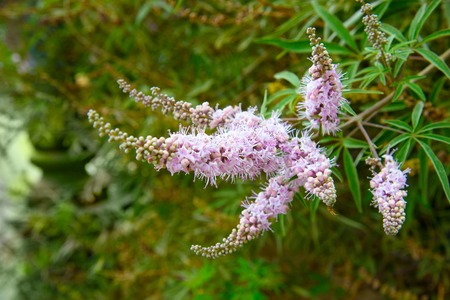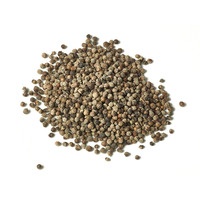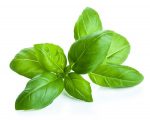
The Chasteberry (Vitex agnus-castus) tree, commonly shortened to ‘vitex’, Abraham’s Balm, Monk’s Pepper, Lilac Chastetree, or the chaste tree as it is often known has been used in ancient folk medicine for treating pre-menstrual tension (PMT). Theophrastus who was an important philosopher following Aristotle references its potency for treating sexual disorders. As far back as Roman times, the fruit and seeds were used to make herbal medicines to treat PMT and minimise the effect of sexual issues. The benefits are still considered controversial.
This deciduous shrub is native to the Mediterranean and Central Asia. The shrub produces long, finger-shaped leaves, with blue-violet flowers, followed by dark purple berries.
Purchase & Availability

Pestle Herbs offers the herbal supplement in both 50g and 100g quantities as dried seeds. Their offering is also organic.
N.B. This post contains links to our affiliate marketing partner. Please read our affiliate disclosure.
Componentry
The main components in both fruit and leaves are iridoid glycosides such as agnuside and aucubin, various flavonoids (vitexin, casticin), numerous alkaloids, essential fatty acids, diterpenoids, some steroidal hormone precursors and p-hydroxybenzoic acid.
Premenstrual Tension
The menstrual cycle is the regular occurrence of periods on a monthly basis. A period lasts for between 3 and 7 days in a healthy woman.
Vitex agnus-castus is taken by mouth for treating various gynaecological and menstrual conditions, and alleviating pain, menstrual cycle irregularities, premenstrual syndrome (PMS), a more severe form of PMS called premenstrual dysphoric disorder (PMDD), and symptoms of menopause. It is also used for treating “lumpy” (fibrocystic) breasts, female infertility, preventing miscarriage in women with low levels of a hormone known as progesterone, controlling bleeding and helping the body force out the placenta after childbirth, and increasing breast milk. The seeds have also been used for treating anxiety during menstrual cycles.
It is thought that many of the compounds in the extract act on the pituitary gland which produces various hormones and regulates the behaviour of others. Extracts apparently bind to opiate receptors which points to the alleviation of pain associated with PMT etc.
Chasteberry As A Diuretic And For Reducing Complications From An Enlarged Prostate
Vitex agnus-castus is also taken by mouth to increase the flow of urine in men, for treating benign prostatic hyperplasia (BPH). It does not reduce sexual desire as was commonly thought but does alter hormone levels as evident in the female reproductive system. Historians claim that monks chewed chaste tree parts to make it easier to maintain their celibacy hence the common name. The latin specific name ‘castus’ actually means chaste.
Chasteberry And Endometriosis
The condition, endometriosis occurs when the lining tissue of the uterus and called the endometrium, forms outside the uterus. Hormonal imbalances and genetic factors are implicated in this development. Inflammation around the uterus is a common symptom with pain and increased bleeding during the menstrual cycle (Vercellini et al., 2014).
It is thought that chasteberry can reduce the degree of inflammation caused by the condition around the uterus. Part of the explanation comes from reducing the hormonal balances which produce this painful condition.
Other Conditions
A few people take Vitex agnus-castus by mouth for acne, nervousness, dementia, joint conditions, colds, upset stomach, spleen disorders, headaches, migraine, eye pain, body inflammation, fractures and swelling.
It may be influential in treating prostate disorders and reducing migraines but this is not yet fully researched.
Some people apply Vitex agnus-castus to the skin to flush out parasites and to prevent insect bites and stings.
Application
Taken as a tincture or infusion, or in tablet and capsule form.
Cautionary And Safety Information
- Vitex agnus-castus supplementation should be avoided during pregnancy due to the possibility of complications.
- Do not give to any child under two years old.
- Do not use while nursing.
- For over 65s, use low levels, infrequently.
Toxicity
The toxicity of the herbal extract has been examined extremely thoroughly (Daniele et al., 2005). The pharmacology and research up to 2003 on the plant has also been assessed (Wuttke et al., 2003).
References
Daniele, C., Coon, J. T., Pittler, M. H., & Ernst, E. (2005). Vitex agnus castus. Drug Safety, 28(4), pp. 319-332
Vercellini, P., Viganò, P., Somigliana, E., & Fedele, L. (2014). Endometriosis: pathogenesis and treatment. Nature Reviews Endocrinology, 10(5), 261-75. https://www.ncbi.nlm.nih.gov/pubmed/24366116



Leave a Reply